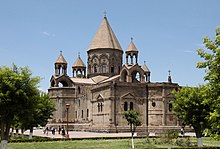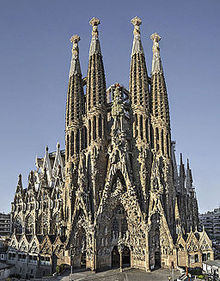
Back عمارة الكاتدرائيات Arabic Arquitectura de las catedrales y las grandes iglesias Spanish Arsitektur katedral dan gereja besar ID 西ヨーロッパの大聖堂建築 Japanese Arquitetura de catedrais e grandes igrejas Portuguese Arhitektura stolnic in velikih cerkev Slovenian สถาปัตยกรรมอาสนวิหารในยุโรปตะวันตก Thai 教堂建筑 Chinese
This article has multiple issues. Please help improve it or discuss these issues on the talk page. (Learn how and when to remove these template messages)
|




Cathedrals, collegiate churches, and monastic churches like those of abbeys and priories, often have certain complex structural forms that are found less often in parish churches. They also tend to display a higher level of contemporary architectural style and the work of accomplished craftsmen, and occupy a status both ecclesiastical and social that an ordinary parish church rarely has. Such churches are generally among the finest buildings locally and a source of regional pride.[1] Many are among the world's most renowned works of architecture. These include St Peter's Basilica, Notre-Dame de Paris, Cologne Cathedral, Salisbury Cathedral, Antwerp Cathedral, Prague Cathedral, Lincoln Cathedral, the Basilica of Saint-Denis, Santa Maria Maggiore, the Basilica of San Vitale, St Mark's Basilica, Westminster Abbey, Saint Basil's Cathedral, Antoni Gaudí's incomplete Sagrada Família and the ancient cathedral of Hagia Sophia in Istanbul, now a mosque.
The earliest large churches date from Late Antiquity. As Christianity and the construction of churches spread across the world, their manner of building was dependent upon local materials and local techniques. Different styles of architecture developed and their fashion spread, carried by the establishment of monastic orders, by the posting of bishops from one region to another and by the travelling of master stonemasons who served as architects.[2] The successive styles of the great church buildings of Europe are known as Early Christian, Byzantine, Romanesque, Gothic, Renaissance, Baroque, Rococo, Neoclassical, and various Revival styles of the late 18th to early 20th centuries, and then Modern.[3] Underlying each of the academic styles are the regional characteristics. Some of these characteristics are so typical of a particular country or region that they appear, regardless of style, in the architecture of churches designed many centuries apart.[3]
© MMXXIII Rich X Search. We shall prevail. All rights reserved. Rich X Search